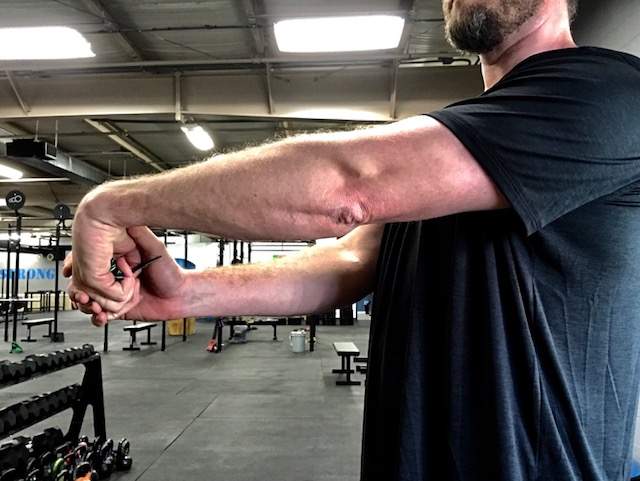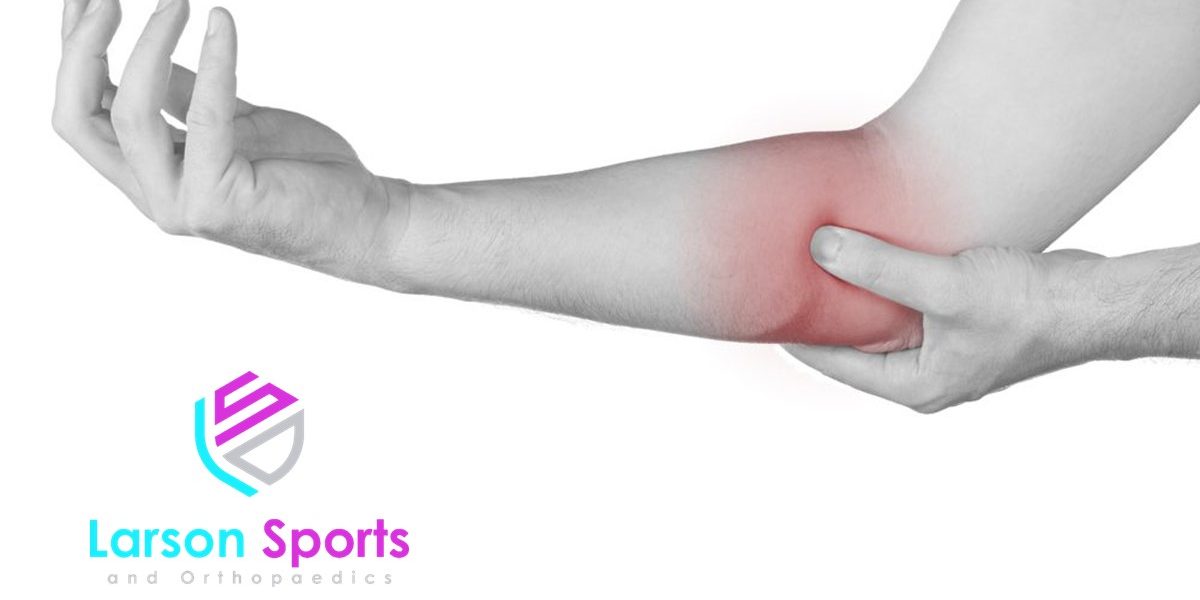Golfer’s Elbow (medial epicondylitis) is a condition that causes pain where the tendons of your forearm muscles attach to the bony bump on the inside of your elbow. The pain might spread into your forearm and wrist. Golfer’s Elbow is similar to tennis elbow (which occurs on the outside of the elbow.) Unfortunately for my readers, golfer’s elbow is a very common problem for weightlifters and people in aggressive high-intensity interval training programs do to the repetitive strain these programs cause to the muscles that grip and lift.
What is golfer’s elbow?
Golfer’s elbow, or medial epicondylitis, is actually tendinitis. Tendinitis is a common problem due to overuse of these tissues, which heal more slowly than your muscles do. Over time you develop progressive microscopic damage to the tendons that build up and cause pain. All those kettlebell swings can be great for your health, but rough on your tendons.
For more on the problem of tendinitis, check out my article “What Is Tendinitis?” Tendinitis is something I see frequently in my orthopedic clinic. I am a specialist in sports medicine and have my CF lvl1 certificate so I treat a lot of weightlifters and athletes. I’ve even had to treat my own tendinitis. It can be really easy to overdo the exercise routine when you start seeing the results! Why can’t your body keep up with your fitness goals?!
Symptoms of Golfer’s Elbow
Golfer’s elbow is characterized by:
- Pain and tenderness. Usually felt on the inner side of your elbow, the pain sometimes extends along the inner side of your forearm. Pain typically worsens with certain movements.
- Stiffness. Your elbow and wrist may feel stiff. It is often painful to stretch the elbow all the way out straight.
- Weakness. You may have weakness in your hands and wrists, especially with grip.
- Numbness or tingling. These sensations might radiate into one or more fingers — usually the ring and little fingers. This is due to swelling causing pressure on the ulnar nerve.
The pain of golfer’s elbow comes gradually. It’s usually the annoying kind of pain that you try and ignore, hoping it will get better on its own. It will be more painful when gripping a barbell, swinging a golf club, or simply lifting a gallon of milk.

Other Causes of Elbow Pain
If you are having elbow pain while lifting and working out, there are many possible causes. Be sure to check out my article on all the different problems if your symptoms don’t match golfer’s elbow exactly: Elbow Pain While Lifting
Risk factors for Golfer’s Elbow
Certain factors can put you at a higher risk of developing tennis elbow, including:
- a rapid increase in exercise frequency or intensity
- not warming up or stretching properly
- using improper technique while exercising
- jobs that require frequent use of hand tools
- most common between 30 and 50 years old
- smoking
Prevention of Golfer’s Elbow
Preventing golfer’s elbow is far better than treating it afterward. Some ways to help prevent golfers elbow include the following:
- Strengthen your forearm muscles. Use some of the Eccentric Strengthening equipment listed in the next section. Even simple exercises can help your muscles absorb the energy of sudden physical stress.
- Be sure to warm up before exercising. Dynamic warm-ups help mobilize the tissue and prevent injury. Stretching afterward can help too.
- Fix your form. Make sure your shoulders and core are properly engaged for your activity. Strong core activation prevents extremity injuries.
- Change equipment. Sometimes dumbbells or kettlebells allow more freedom of movement than a barbell. If you have limitation to the range of motion in the wrist, elbow, or forearm then a barbell may cause excessive strain on the elbow tendons.
- Know when to rest. Try not to overuse your elbow. At the first sign of elbow pain, take a break. And don’t go crazy at the gym. Studies show that performing more than ten sets of weight lifting per muscle group each week can actually reduce your strength gains and put you at risk for overtraining injuries.
Home Treatment of Golfer’s Elbow
The best initial treatments for golfer’s elbow are the same treatments we recommend for any case of tendinitis. It’s always a good idea to start with “RICE.”
R: Rest. Stop doing the exercises that bother it. No curls, no pull-ups. Other exercises that may cause problems would include deadlifts, cleans, and kettlebell swings.
I: Ice. Icing the painful area can help to decrease pain and swelling. But using heat can help with the healing of the tendon so I recommend doing that after you have used the ice.
C: Compression. A golfer’s elbow counterforce brace can help reduce pain and swelling too.
E: Elevate. Okay, so this is part of the acronym but it’s really not helpful to elevate an elbow with tendinitis. Move along, these aren’t the droids you’re looking for.
Eccentric Exercise:
Once the tendon has settled down a bit, you can try eccentric exercises to help heal the elbow. There is a wide variety of exercise equipment that can help recover from golfer’s elbow. Some of the most widely used include the Theraband FlexBar, Flexion Strengthener, or Hand Therapy Discs.
Bracing for Golfer’s Elbow:
Counterforce braces can help to decrease the tension on the elbow tendons. This can help reduce the damage sustained during exercise. They can also reduce elbow pain during daily activities while you get better. Sometimes a simple elbow sleeve can help if the counterforce braces are too stressful on the tendon.
Adjusting your Workout:
It is often possible to reduce the amount of gripping you do during a workout. You can decrease the weights to levels that are comfortable and don’t produce pain. Alternatively, Ab Straps can be used instead of gripping the bars on a rig for ab exercises. Can’t live without deadlifting? In that case, Wrist Straps or Hooks can also be used to reduce the grip strain while using a barbell. Use these to keep exercising without as much strain to the tendons of the elbow. Adjust your workout routine so that you aren’t doing grip-intensive workouts more than twice a week. And consider using dumbbells and kettlebells instead of just barbells. It can reduce the torque on your elbow.
Stretching:
It can also be very helpful to stretch the forearm and wrist. Be sure to stretch both directions! These are easy to do. Just keep the arm out straight in from of you, and bend the wrist up or down. Use your other arm to stretch the wrist in one up or down, keeping the elbow straight. You should feel the stretch through the entire forearm.

Cuff Strengthening:
Rotator cuff strengthening is also very helpful. Many forms of tendinitis at the elbow are actually down-stream effects of having a weak rotator cuff. Here is an article to help with that: Exercises to Strengthen Your Shoulder.
Golfer’s Elbow Treatment By a Doctor
If your elbow is still painful after a couple of weeks of this treatment, it’s a good idea to see your doctor for further care. As a doctor, we can provide further treatments to help fix the tendinitis. Keep in mind that these treatments can’t cure the tendinitis if you don’t help out by reducing the exercises that are causing pain. Recovery is a two-way street, and physicians need you to be part of the solution!
Diagnosis: Imaging Studies
X-rays are often ordered at the initial visit with a doctor. These are used to look for other causes of elbow pain they don’t really show the tendon itself. MRI or ultrasound can be used to see the tendon directly, but may not show any abnormality in many cases of tendinitis. That’s why an MRI is usually only ordered after the pain has failed to respond to everything else. When the diagnosis is obvious you may not need an MRI at all.
Injections
Corticosteroid injections can help to reduce pain and swelling. I don’t typically offer cortisone injections more than a couple times. They can decrease the healing response and aren’t great for tendon metabolism. Instead, I often use Toradol injections now. Toradol is a high-strength anti-inflammatory medication that doesn’t damage the tendon. But still, if you’ve have two or three of these without success, it’s time to check out your other options.
Platelet-Rich Plasma (PRP)
PRP injections use your own body to speed healing. PRP involves taking a sample of your blood and then concentrating the platelets and other factors involved in healing. This preparation is then injected back into the tendon. This helps stimulate healing so it can repair itself.
You can read more in our article PRP: Can It Help You?
Physical Therapy
Physical therapy may also be an option to help treat your triceps tendinitis. These include ultrasound, e-stim, IASTM, and eccentric strengthening protocols to help rebuild the tendon. For more on IASTM, you can read our interview with Scott Dolly: Fixing Fascia
Surgery
It is rare that golfer’s elbow will require surgery. In this case, the treatment usually requires a small incision to remove the damaged tendon tissue. The tendon is then repaired back together with sutures. It is also possible to do ultrasound-guided debridement of the damaged tissue. Some of us even perform arthroscopic treatment, with release of the tissue from the inside. It will require about six weeks to heal after surgery. And then you can begin rehab and strengthening slowly after that.
Recovery from Golfer’s Elbow
Tendinitis can take months to fully resolve. It is not unusual for it to take 6 months or more for the pain to completely go away. Many of the methods above can help speed that recovery though. Regardless of the severity of your tendinitis, it’s important to remember that everyone heals at a different rate. Additionally, it’s very important to return to full activity slowly. Start back too hard and too fast, you’re at risk of simply repeating your injury.
Reference Articles:
Diagnosis and treatment of medial epicondylitis of the elbow.
Medial epicondylitis: evaluation and management
Disclaimer: This article does contain affiliate links. If you choose to purchase any of them, it does give a little money to the LSO website so we can keep working on our goal of helping more people move better, longer. You never pay any extra by using these links. Thanks for your support.

